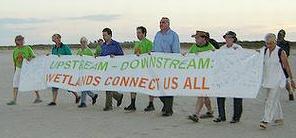 澳洲工黨政府2月2日在世界溼地日的活動儀式上,針對前自由黨政府對於拉姆薩溼地公約下正式指定的65處溼地管理方式,做出強烈的抨擊。
澳洲工黨政府2月2日在世界溼地日的活動儀式上,針對前自由黨政府對於拉姆薩溼地公約下正式指定的65處溼地管理方式,做出強烈的抨擊。
世界溼地日主要是紀念1971年2月2日各國在伊朗裡海海岸城市拉姆薩共同簽署溼地公約。
拉姆薩公約概況研究報告針對澳洲65處溼地的現況及管理進行檢視,以及評估溼地文件記綠的完整度及流通性。
庫隆、下湖和墨瑞河口區域屬南澳國家公園和潟湖生態區,位於阿德萊德東南方約156公里。此溼地形成在澳洲最長且最大的墨瑞河終點,而海水、河水、雨水和地下水的複雜交錯也是此國家公園的特色。
庫隆、亞歷山大和艾伯特湖以及其他澳洲溼地正迅速地乾枯,根據澳洲聯邦政府的報告顯示,至2007年11月底的兩年時間,是墨瑞河2年入流量最低的一次記錄。
 專家學者將溼地的乾枯歸咎於氣候變化。2008年5月,墨瑞-達令流域委員會(Murray-Darling Basin Commission)執行長克瑞克博士公佈澳洲政府的結論:「有越來越多的證據顯示,澳洲東南方降雨量和逕流的減少,與氣候變化有關。」聯邦和南澳政府也計劃透過下湖區將海水引入淡水溼地。
專家學者將溼地的乾枯歸咎於氣候變化。2008年5月,墨瑞-達令流域委員會(Murray-Darling Basin Commission)執行長克瑞克博士公佈澳洲政府的結論:「有越來越多的證據顯示,澳洲東南方降雨量和逕流的減少,與氣候變化有關。」聯邦和南澳政府也計劃透過下湖區將海水引入淡水溼地。
2008年10月,澳洲綠黨就庫隆和下湖區水資源管理在參議院進行質詢時發現,與聯邦政府的悲觀看法相反,到了2009年9月總計約600億公升的乾淨水源,足夠短期供應亞歷山大和艾伯特湖的復育,減緩湖泊乾涸和酸化的程度。
庫隆生態危機事實上已有時日,2005年維多利亞國家公園協會的羅伯特斯就曾表示:「澳洲簽署拉姆薩公約來證明我們會將庫隆的生態維持在1985年時的狀態,但我們正在違背這項承諾。」
澳洲環境部長蓋瑞特在世界溼地日發表的談話中譴責前任政府,而針對拉姆薩公約概況研究報告他則表示:「報告中一頁接著一頁都點出澳洲在落實拉姆薩公約時,面臨嚴重生態和管理方面的問題及挑戰,以及過去執行層面的疏失,並就澳洲在履行拉姆薩公約時需加以改善的部分提出建議。」
Today, Australia's Labor government used the occasion of World Wetlands Day to slam the former Liberal government for its treatment of the country's 65 wetlands that are officially designated under the Ramsar treaty.
World Wetlands Day marks the date of the signing of the Convention on Wetlands on February 2, 1971, in the Iranian city of Ramsar on the shores of the Caspian Sea.
The Ramsar Snapshot Study Report looks at the status and management of all 65 Australian Ramsar sites and assesses the completeness and currency of Ramsar site documentation for Australian Ramsar sites.
The Coorong, Lower Lakes and Murray Mouth region is a national park and lagoon ecosystem in South Australia, 156 kilometers southeast of Adelaide. This wetland forms at the terminus of the longest and largest river in Australia, the River Murray. The park is characterized by a complex interaction of sea water, the river water, rainfall and groundwater.
The Coorong and Lakes Alexandrina and Albert Ramsar site and many other Australian wetlands are increasingly drying. The two year period to the end of November 2007 is the lowest Murray System two year inflow period on record, according to a federal government report.
Experts are blaming the drought on climate change. In May 2008, Murray-Darling Basin Commission Chief Executive Dr. Wendy Craik announced the Australian government's conclusion that, "There is growing evidence that lower rainfall and reduced runoff in southeast Australia is linked to climate change."
The federal and South Australia governments have proposed to allow saltwater to flow into the freshwater wetlands through the lower lakes.
In October 2008, the Greens' Senate Inquiry into water management in the Coorong and Lower Lakes found that, "contrary to the federal government's pessimistic view," a total of 60 gigalitres of fresh water by September 2009 is all that is required to provide enough environmental flow to stop Lakes Alexandrina and Albert from drying up and acidifying in the short term.
The Coorong crisis has been building over a long time. In 2005, Nick Roberts of the Victorian National Parks Association said, "Australia has signed the Ramsar treaty to say we would maintain the ecological character of the Coorong as it was in 1985. We are failing this promise."
In his World Wetlands Day message, Environment Minister Garrett blamed the previous government. Of the Snapshot Report, he said, "Page after page highlights the serious ecological and management issues and challenges regarding Australia's Ramsar Convention administration, the failures of the past and suggests a number of areas where implementation of the Ramsar Convention in Australia can be improved."









